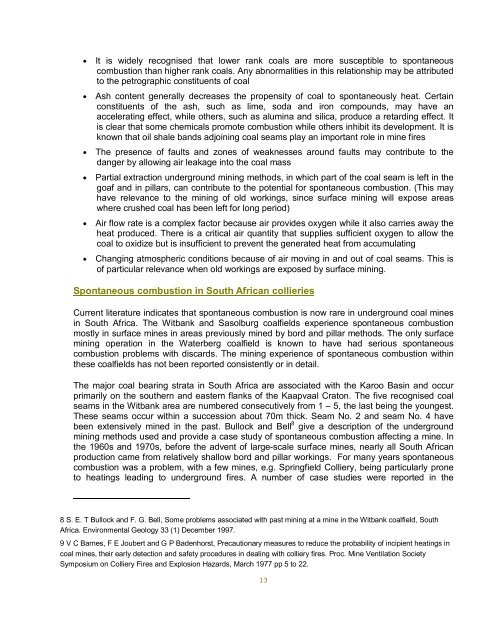prevention and control of spontaneous combustion - Mining and
prevention and control of spontaneous combustion - Mining and
prevention and control of spontaneous combustion - Mining and
Create successful ePaper yourself
Turn your PDF publications into a flip-book with our unique Google optimized e-Paper software.
• It is widely recognised that lower rank coals are more susceptible to <strong>spontaneous</strong><br />
<strong>combustion</strong> than higher rank coals. Any abnormalities in this relationship may be attributed<br />
to the petrographic constituents <strong>of</strong> coal<br />
• Ash content generally decreases the propensity <strong>of</strong> coal to <strong>spontaneous</strong>ly heat. Certain<br />
constituents <strong>of</strong> the ash, such as lime, soda <strong>and</strong> iron compounds, may have an<br />
accelerating effect, while others, such as alumina <strong>and</strong> silica, produce a retarding effect. It<br />
is clear that some chemicals promote <strong>combustion</strong> while others inhibit its development. It is<br />
known that oil shale b<strong>and</strong>s adjoining coal seams play an important role in mine fires<br />
• The presence <strong>of</strong> faults <strong>and</strong> zones <strong>of</strong> weaknesses around faults may contribute to the<br />
danger by allowing air leakage into the coal mass<br />
• Partial extraction underground mining methods, in which part <strong>of</strong> the coal seam is left in the<br />
goaf <strong>and</strong> in pillars, can contribute to the potential for <strong>spontaneous</strong> <strong>combustion</strong>. (This may<br />
have relevance to the mining <strong>of</strong> old workings, since surface mining will expose areas<br />
where crushed coal has been left for long period)<br />
• Air flow rate is a complex factor because air provides oxygen while it also carries away the<br />
heat produced. There is a critical air quantity that supplies sufficient oxygen to allow the<br />
coal to oxidize but is insufficient to prevent the generated heat from accumulating<br />
• Changing atmospheric conditions because <strong>of</strong> air moving in <strong>and</strong> out <strong>of</strong> coal seams. This is<br />
<strong>of</strong> particular relevance when old workings are exposed by surface mining.<br />
Spontaneous <strong>combustion</strong> in South African collieries<br />
Current literature indicates that <strong>spontaneous</strong> <strong>combustion</strong> is now rare in underground coal mines<br />
in South Africa. The Witbank <strong>and</strong> Sasolburg coalfields experience <strong>spontaneous</strong> <strong>combustion</strong><br />
mostly in surface mines in areas previously mined by bord <strong>and</strong> pillar methods. The only surface<br />
mining operation in the Waterberg coalfield is known to have had serious <strong>spontaneous</strong><br />
<strong>combustion</strong> problems with discards. The mining experience <strong>of</strong> <strong>spontaneous</strong> <strong>combustion</strong> within<br />
these coalfields has not been reported consistently or in detail.<br />
The major coal bearing strata in South Africa are associated with the Karoo Basin <strong>and</strong> occur<br />
primarily on the southern <strong>and</strong> eastern flanks <strong>of</strong> the Kaapvaal Craton. The five recognised coal<br />
seams in the Witbank area are numbered consecutively from 1 – 5, the last being the youngest.<br />
These seams occur within a succession about 70m thick. Seam No. 2 <strong>and</strong> seam No. 4 have<br />
been extensively mined in the past. Bullock <strong>and</strong> Bell 8 give a description <strong>of</strong> the underground<br />
mining methods used <strong>and</strong> provide a case study <strong>of</strong> <strong>spontaneous</strong> <strong>combustion</strong> affecting a mine. In<br />
the 1960s <strong>and</strong> 1970s, before the advent <strong>of</strong> large-scale surface mines, nearly all South African<br />
production came from relatively shallow bord <strong>and</strong> pillar workings. For many years <strong>spontaneous</strong><br />
<strong>combustion</strong> was a problem, with a few mines, e.g. Springfield Colliery, being particularly prone<br />
to heatings leading to underground fires. A number <strong>of</strong> case studies were reported in the<br />
8 S. E. T Bullock <strong>and</strong> F. G. Bell, Some problems associated with past mining at a mine in the Witbank coalfield, South<br />
Africa. Environmental Geology 33 (1) December 1997.<br />
9 V C Barnes, F E Joubert <strong>and</strong> G P Badenhorst, Precautionary measures to reduce the probability <strong>of</strong> incipient heatings in<br />
coal mines, their early detection <strong>and</strong> safety procedures in dealing with colliery fires. Proc. Mine Ventilation Society<br />
Symposium on Colliery Fires <strong>and</strong> Explosion Hazards, March 1977 pp 5 to 22.<br />
13

















